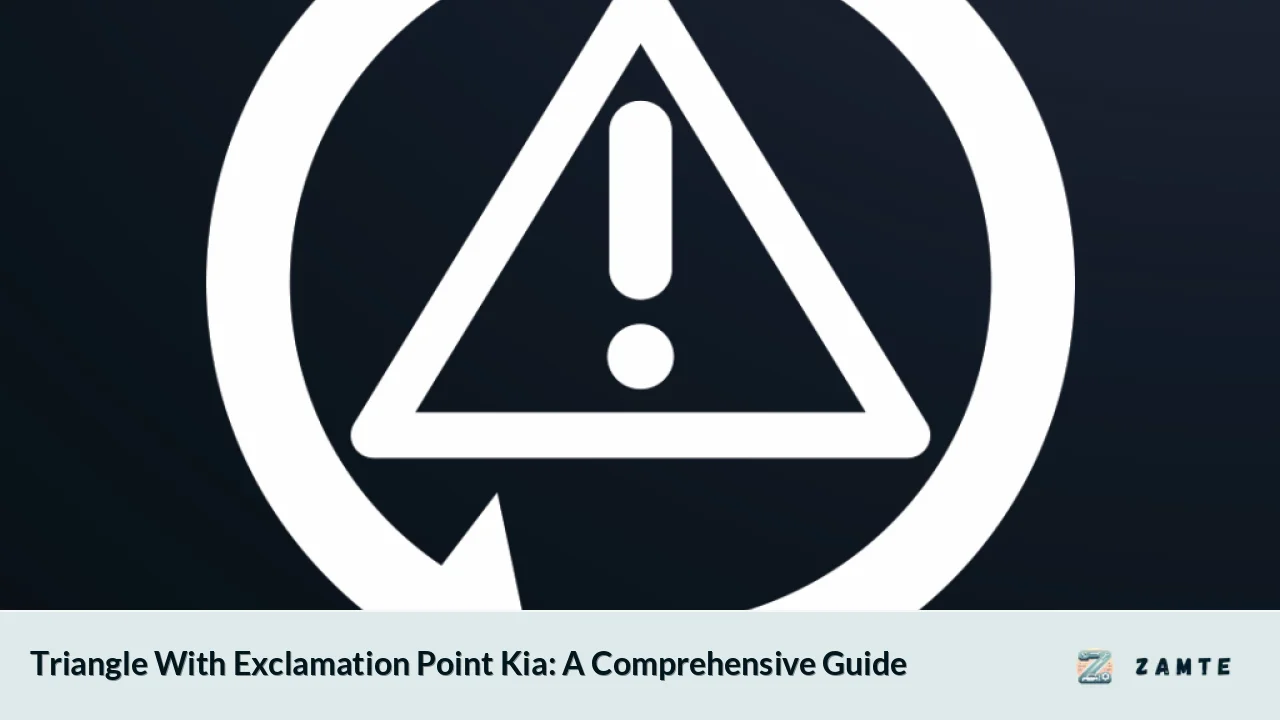The Kia triangle with an exclamation point warning light is a critical indicator that alerts drivers to potential issues within their vehicle. This article aims to explore the meaning of this warning light, its implications, common causes, and recommended actions. By understanding this warning, drivers can ensure their safety and the longevity of their Kia vehicle.
The dashboard of a vehicle serves as a communication hub between the driver and the car's various systems. Among the many indicators, the triangle with an exclamation point is particularly significant. It is not merely a decorative symbol; it signifies that something requires immediate attention. Ignoring this warning can lead to more severe problems, potentially compromising both safety and vehicle performance.
Importance of Dashboard Warning Lights
Dashboard warning lights are designed to inform drivers about various operational aspects of their vehicles. Each light has a specific meaning, and understanding these signals is crucial for maintaining vehicle health. The triangle with an exclamation point is categorized as a master warning light, indicating multiple potential issues that need addressing.
Overview Table
| Warning Light | Description | Action Required |
| Triangle with Exclamation Point | Indicates multiple system warnings | Immediate inspection needed |
| Check Engine Light | Engine or emission system issue | Diagnostic check required |
| Oil Pressure Light | Low oil pressure | Stop engine immediately |
| Battery Warning Light | Charging system issue | Visit service center |
What Does the Triangle with Exclamation Point Mean?
The triangle with an exclamation point serves as a master warning light on Kia dashboards. When illuminated, it indicates that one or more critical systems in the vehicle are malfunctioning. These systems may include:
- Tire Pressure Monitoring System (TPMS): Alerts you to low tire pressure.
- Brake Fluid Level: Signals low brake fluid levels.
- Washer Fluid Level: Notifies you when windshield washer fluid is low.
- Blind Spot Detection System: Indicates a malfunction in the blind spot monitoring system.
When this light activates, it is essential to address the underlying issues promptly to avoid further complications.
Common Causes of the Warning Light
Several factors can trigger the triangle with an exclamation point warning light. Understanding these causes can help drivers take appropriate actions:
- Low Tire Pressure: One of the most common reasons for this warning light is low tire pressure, which can affect handling and fuel efficiency.
- Low Brake Fluid: Insufficient brake fluid can compromise braking performance, leading to dangerous situations.
- Washer Fluid Level: While not critical for safety, low washer fluid can impair visibility during adverse weather conditions.
- System Malfunctions: Issues with electronic systems such as the Blind Spot Detection or other safety features may also cause this light to illuminate.
Importance of Regular Maintenance
Regular maintenance checks are essential for preventing these warning lights from activating. Routine inspections can identify potential issues before they escalate into significant problems.
What to Do When You See This Warning Light
Upon noticing the triangle with an exclamation point on your dashboard, follow these steps:
1. Stay Calm: Maintain control of your vehicle and avoid sudden maneuvers.
2. Pull Over Safely: Find a safe location to stop your vehicle. Turn on your hazard lights to alert other drivers.
3. Check for Immediate Issues: Inspect your tires for visible damage or low pressure. Check brake fluid levels if accessible.
4. Consult Your Owner’s Manual: Refer to your vehicle’s manual for specific guidance related to dashboard warnings.
5. Seek Professional Help: If the light remains illuminated after checking basic issues, visit a certified Kia service center for a thorough diagnostic check.
Emergency Response Steps
In case of severe malfunctions indicated by this warning light, follow these emergency response steps:
- Gradually reduce speed and pull over.
- Turn off the engine if necessary.
- Contact roadside assistance if you cannot resolve the issue on your own.
Preventive Measures
To minimize the risk of encountering the triangle with an exclamation point warning light, consider implementing these preventive measures:
- Regular Maintenance: Schedule routine maintenance checks at authorized service centers to ensure all systems are functioning correctly.
- Monitor Fluid Levels: Regularly check and top off brake fluid, washer fluid, and engine oil levels.
- Tire Maintenance: Conduct regular tire pressure checks and rotations to ensure even wear and optimal performance.
Benefits of Preventive Maintenance
Engaging in preventive maintenance not only enhances vehicle performance but also extends its lifespan. By addressing minor issues before they escalate, drivers can save on costly repairs in the long run.
Conclusion
The Kia triangle with an exclamation point is more than just a dashboard symbol; it serves as a vital communication tool that alerts drivers to potential issues within their vehicles. Understanding what this warning light signifies and how to respond effectively can prevent serious problems down the road.
By prioritizing regular maintenance and being proactive about vehicle care, Kia owners can enjoy a safer driving experience while ensuring their vehicles remain in optimal condition.
FAQs
- What does the Kia triangle with exclamation point mean?
It indicates that there are multiple system warnings that require immediate attention. - Can I continue driving with this warning light on?
It is not advisable; you should pull over safely and investigate the cause. - What should I do if I see this warning light?
Pull over safely, check for immediate issues like tire pressure or fluid levels, and consult your owner’s manual. - How can I prevent this warning from activating?
Regular maintenance checks and monitoring fluid levels can help prevent activation. - Is it safe to ignore this warning light?
No, ignoring it could lead to more severe issues affecting safety and performance.
